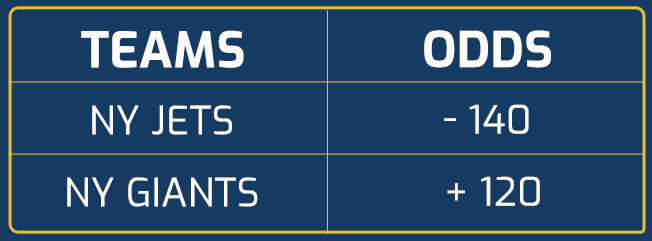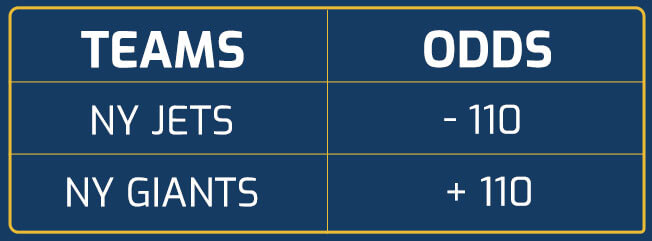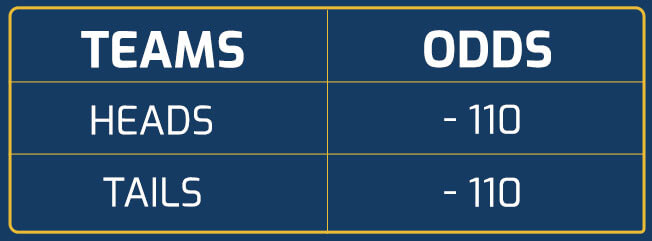Understanding NFL Odds and Payouts
The “NFL odds” in NJ sportsbooks are expressed as a pair of numbers for each side of the bet. The odds may also be referred to as the “line”, or the “spread”.
Here is a typical example of an NFL “money line” with the wagering NFL odds for a game:

In this “money line” example, the NY Jets are the favorite. A bet of $140 will return a payout of $100 in winnings, plus the original bet amount of $100, for a total payout amount of $240.
Point spreads are not involved in a moneyline bet. You select the winner of the game and the payout listed. The odds are aligned with the payout.
In the example above, the NY Jets were determined to be the likely winner by the sportsbook’s analysts. A bettor would receive less than “even money” if the NY Jets were to win the game.
The favorite is always the negative number in the pair. The positive number is the payout for the “underdog”. For the favorite, the more probable the win, the lower the payout, and the opposite holds for the underdog.
Notice in the example above, the matched pair does not sum to zero when added together. A bettor only receives $120 for $100 bet on a Giants win, while a matched bet on the Jets side requires an outlay of $140.
The difference is the sportsbook’s commission. The difference is sometimes referred to as the “vigorish,” the “vig” for short, or the “juice”.
This commission is collected by the sportsbook. It is used to run an efficient and fully compliant NFL betting market.
Even Money Bet
The concept of “even money” implies there is no clear favorite in the game. With moneyline bets, the payout is aligned with the NFL odds.
Here is our NFL example, where the odds are even, payouts are even, and the same “vig” applies to either side.
This type of betting situation is referred to as a “pick-em” game – odds imply that either team is equally likely to win.

Point Spread Bet
The moneyline example above is one type of betting format that is common with MLB wagering. However, it is popular with NFL bettors as well. A more common NFL and NBA betting format is the point spread bet.
Here is a typical example of an NFL point spread odds for a game. The NY Jets are favored and need to win by 4 points to “beat the spread”:

With point spread betting, the payouts are usually even. But, the favorite is assigned a negative point hurdle. These points must be covered to win the bet, hence the term “cover the spread”.
Above, if the Giants were to lose the game by a field goal (3 points), a winning wager would be a bet on the Giants at +3.5. As a note, the .5 is usually part of the point spread and is referred to as the “hook”.
This half-point is there to support betting action, and avoid ties or a “push”. In the event of a point spread tie on a single bet, you get your wager returned to you.
Two-Way Action
The point spread is a type of “balancer” to ensure two-way action. This is given the payout is the same and the Jets are the favorite. Two-way action is essential to the sportsbook in all NFL betting lines.
The sportsbook is not in the business of picking winners. Instead, they collect their commission with little to no risk.
In our example above, the ideal situation is a large volume of wagers on the game. Here, the total value of the bets is exactly the same for both teams.
A betting line that results in equal action on both sides implies zero-risk to the sportsbook. Regardless of the game outcome, the sportsbook collects the maximum commission.
As a bettor, you need to identify value in the NFL odds offered. You must know that the sportsbook’s NFL betting lines are developed to meet the balanced action required for each sports event.
Understanding Probability
Before we discuss the basic techniques of betting, let’s review assessing NFL betting odds. An understanding of probability theory can provide a good starting point.
This will help with analyzing the betting lines offered by New Jersey sportsbooks.
A bet on any event and the associated payout amounts are driven by an estimate of the probable outcome. It can also be driven by the expected value.
An estimate of the probable outcome times the payout is the expected bet value. It is not necessary to dig out your Stats 101 text, but some basic probability concepts will help.
Especially when you want to apply a consistent betting strategy. Make the bet when your estimate of probable win percentage offers a positive value.
Simple Even Odds Example
We can use the simple example of a coin flip to get an understanding of probability. It relates to a typical point spread line.
You and a friend bet on the flip of a coin 1000 times. As we know, the probability of heads winning the flip is 50%. It’s one outcome (heads) out of two possibilities (heads or tails).
We can use the simple example of a coin flip to get an understanding of probability. The sportsbook would put up this line for a single “flip” event as follows:

Finding Value in NFL Odds
In this example above we use “implied” NFL odds to find betting value. What are these numbers telling us in terms of a likely win percentage versus the payout?
In this coin flip betting line, we want to look at the “implied” odds. This is for the possible value in a Heads bet of $110 for a profit of $100 or a total payout of $210.
The implied odds are determined as follows:
The bet amount divided by (payout + bet amount).
For the Heads or Tails example, the implied NFL odds are as follows: The bet amount of $110 divided by (payout $100 + bet amount $110).
For this calculation we ignore the negative sign: =110/210 = .524, the implied ODDs =52.4%,
Implied odds of 52.4% means a bet on Heads to win a coin flip, expects a win rate of a little more than 52 times. This is out of 100 to break even.
We know the probability is only 50%, so we would pass on this bet. We know we expect to win half the coin flip bets and lose the other half. If we were to bet $110 on the coin flip example, our win payout is $100 and a loss costs us $110.
What if the bet changed to how likely a random person is to call Heads on the flip of a coin?
In this example, we are not betting on the results of a flip, but what would a random person call pre-flip? Assume we know from our research and preparation that more people are likely to call Heads. We estimate the probability of a person calling heads = 58%.
Given the same NFL odds of -110, we would take this bet. This is because our expected win percentage of 58% exceeds the implied odds of 52.4%.
The process of finding value in the NFL betting lines requires an analysis of the implied odds. Check the odds offered by the sportsbook compared to your independent win probability.
Figuring out a team’s likely win percentage for a specific game is more complex than the coin flip scenario. It is not necessary to go through the math.
However, successful sports bettors are always improving their sense of likely outcome. This being relative to the NFL odds offered.